The Game Master
In Whitefish, a new world is emerging for tabletop gamers, which for Jeff Irving means his longtime fantasy is close to becoming a reality
By Mike Kordenbrock
For nearly 30 years, the world of Vrahode has lived in the heart and mind of Jeff Irving. But for the last three years, map by map, piece by piece, card by card, and rule by rule, the fantasy world and gaming system he has created, and has long held dear, is emerging into a fully fledged tabletop adventure board game.
Over the course of his adult life, Irving has owned and operated a computer and computer game business, and he has worked extensively in the marketing industry. He’s also the founder of Weathervane Games, a gaming company whose offices consist of a desk and a table just off the kitchen of his Whitefish home, and which is sustained by a remotely connected group of contracted artists, designers and other collaborators spread out across the globe, with contributors in the United States, Europe, South America and Australia.
In explaining the world of Vrahode, as well as what sets it apart from other fantasy worlds, Irving describes it as a departure from the fantasy realms that typically draw their inspiration from medieval Europe. It’s influenced in part by premodern African civilizations and cultures and doesn’t include typical species like dwarves, elves and humans. Instead, there are races like the tree-like Toreln, mushroom-like Mynoc, centaur-like Cautuuk, and reptilian Drelrhune. There is no magic in Vrahode, but there is a similar power players can wield called ruhl.
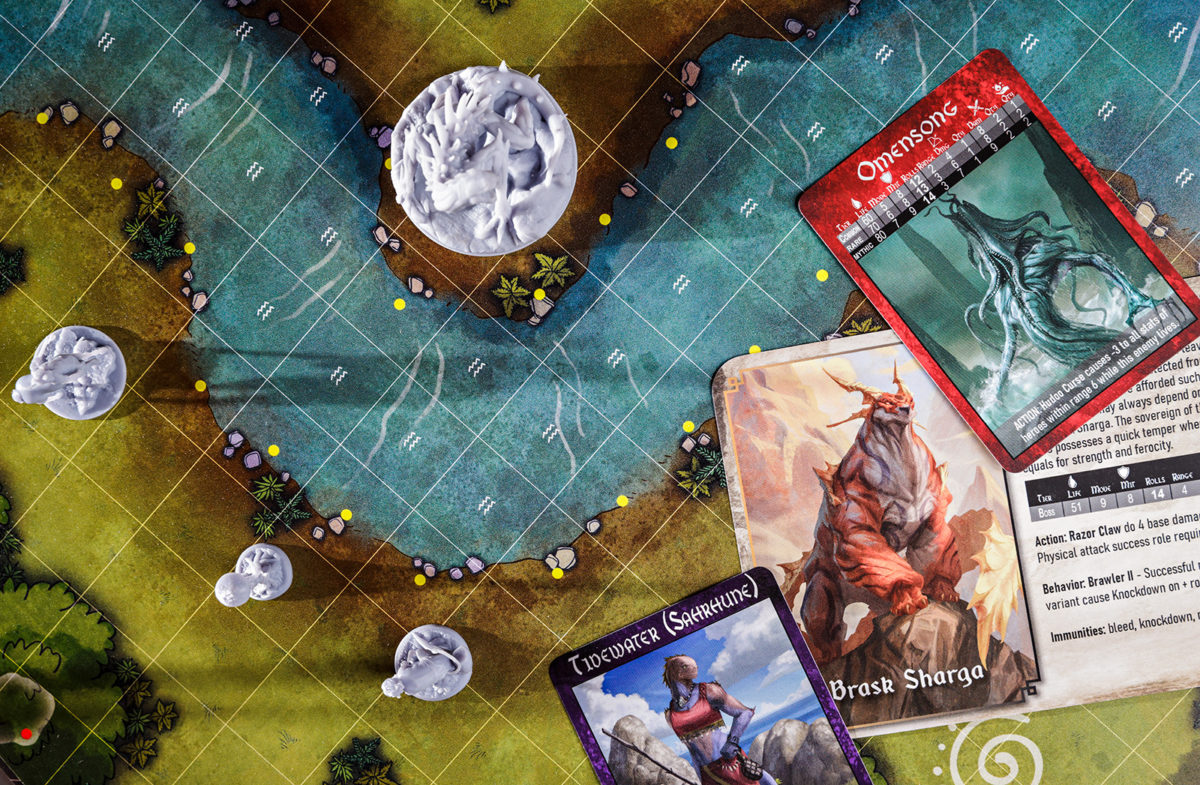

Irving grew up in Indiana, and at a young age was introduced to the roleplaying game Dungeons and Dragons by a friend. He was skeptical at first, especially considering that the game as they played it mostly relied on pencil, paper and imagination. It was his first introduction to the world of fantasy, and it sparked a lifelong fascination with the genre.
He was already a fan of more traditional games by Milton Bradley or Monopoly creators the Parker Brothers, so the merging of his passion for fantasy and games was a natural development. In college at Ball State University he started to envision Vrahode, and then in 1990, while recovering from double pneumonia, Irving wrote what he called a sociological text for the primary races that inhabit the world of Vrahode. It came out to about 250 pages.“Is this a matrilineal descent pattern? Is it patrilineal? What are their birth rituals, what are their death rituals? Do they interact with other races? What are those interactions like? Do they barter, do they trade, what are their goods, what makes them tick? And their magic, if this race exists within the swamps, well then you would expect their magic to be kind of based around water. So it was kind of, how do you do sociology for a magical race?” Irving said, smiling just before breaking out into laughter. “It was so fun.”
The deep dive was a way for Irving to bring in another one of his passions: anthropology. He said when he first learned about tribes in the Amazon that had never had contact with the outside world it was unlike anything he’d ever considered before, and it set off his imagination.
Irving has written in traditional forms such as fiction and poetry, and at first thought of Vrahode as something that could be developed into a fantasy book. Eventually, though, he decided that his tendency to become intensely preoccupied with each word and detail transformed the act of writing into something he didn’t particularly enjoy, which helped send him down the path of conceptualizing Vrahode as a game. He’s brought on Virginia-based writer Shawn Dressler as the lead writer and game design consultant to help shoulder the workload for writing the game book which guides characters through Vrahode.
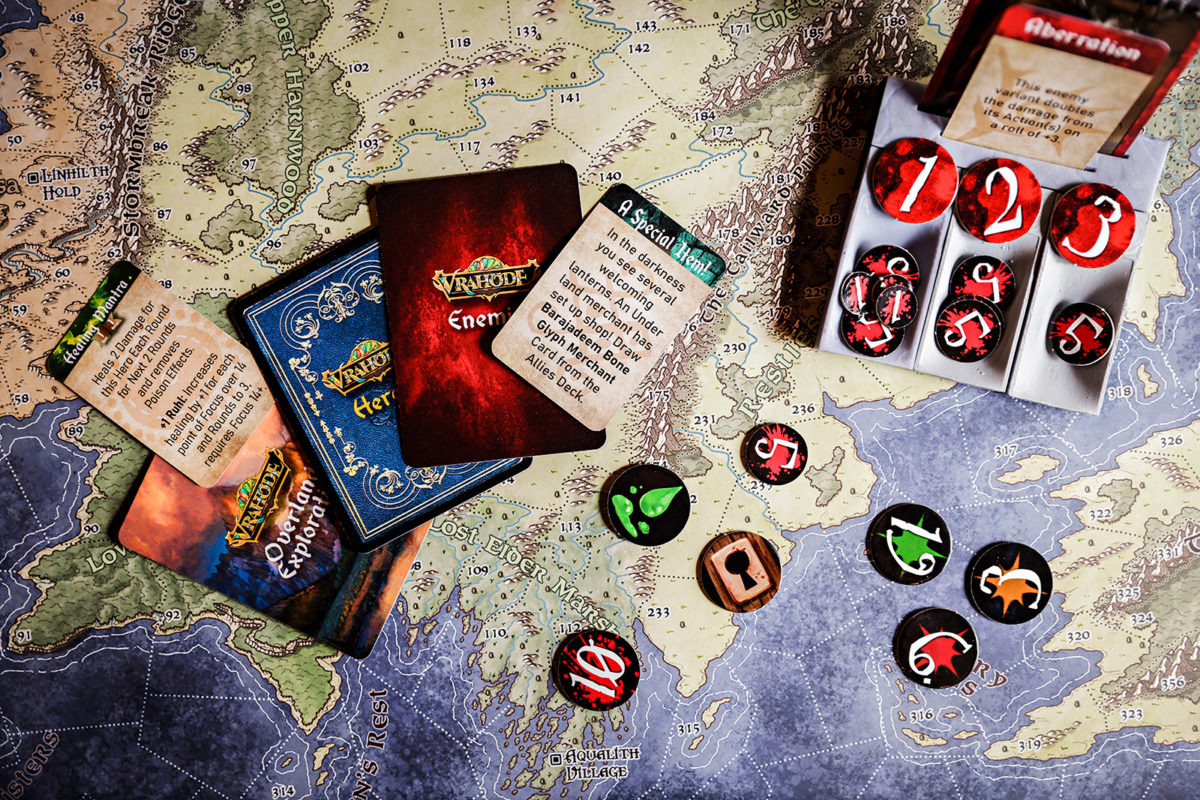
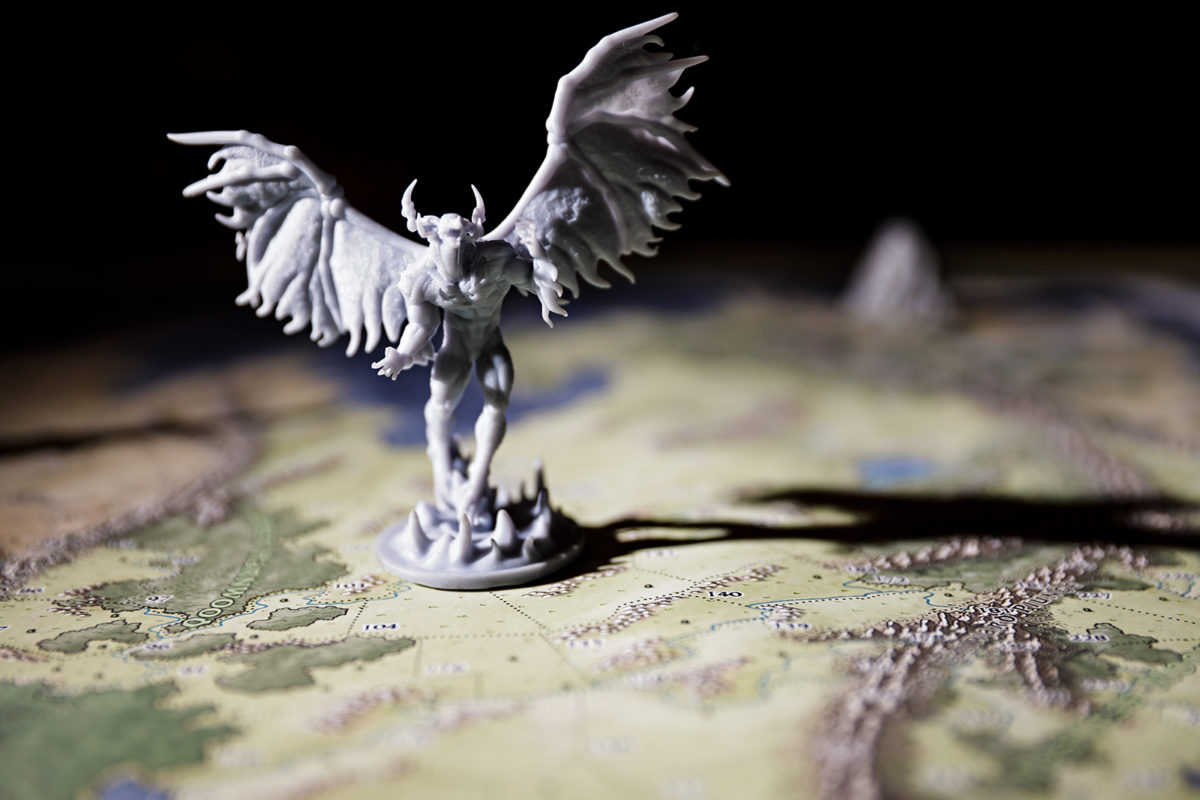
An early iteration of Vrahode was contained in Irving’s description of a “war game,” which is a genre of tabletop game in which players battle each other with armies. It didn’t feel right, however, so he started developing an adventure-style version.
Life eventually got in the way of the creative process, and at one point Irving said he was struggling with depression. He left the game untouched for almost 13 years, but it never fully left him. About three years ago, he decided to recommit himself in earnest, turning his fantasy of completing the game into a reality.
According to Irving’s estimates, he’s invested tens of thousands of dollars into the game at this point.
“I don’t care if I see anything back out of it. What I want to do is share this with people, because it’s gonna be fun. And I want to be able to sit down at a table with people and play in a world that’s been in my head since flipping 1990,” Irving said.
While Irving isn’t preoccupied with profits at this point, he’s also aware that the board game industry is expected to bring in $3.1 billion in revenue in 2022, according to the marketing website Statista.
Irving is planning for Vrahode to consist of a core game called “Vrahode—The Calteeryn Ascension,” and then three expansions. Calteeryn is a reference to a prophesied hero critical to the Vrahode storyline. A group of players will pick one member to be the Calteeryn, which comes with some added perks. The downside, as Irving explained, is that the various monsters of Vrahode tend to direct their hostility first and foremost at the Calteeryn. Vrahode is meant to have variable modes of play so that people can play in a range of settings, including by themselves or in groups of up to six people. The game will also have different modes of difficulty, and the Vrahode Game System under which the game operates will give players a chance to further create and experiment if they want to move beyond some of the established storylines in the game.
An elaborately designed map serves as the primary game board, but during various encounters and battles, players will be directed to separate game boards that enlarge the terrain to represent settings like a desert, a marsh, a tundra, a mountainside, or a dungeon. Players each have a small plastic card tray, which holds a card for the hero they select or create, as well as cards for items, abilities and other tokens to track things like “ruhl.” Dice rolls can dictate the success of some player actions in combat situations.
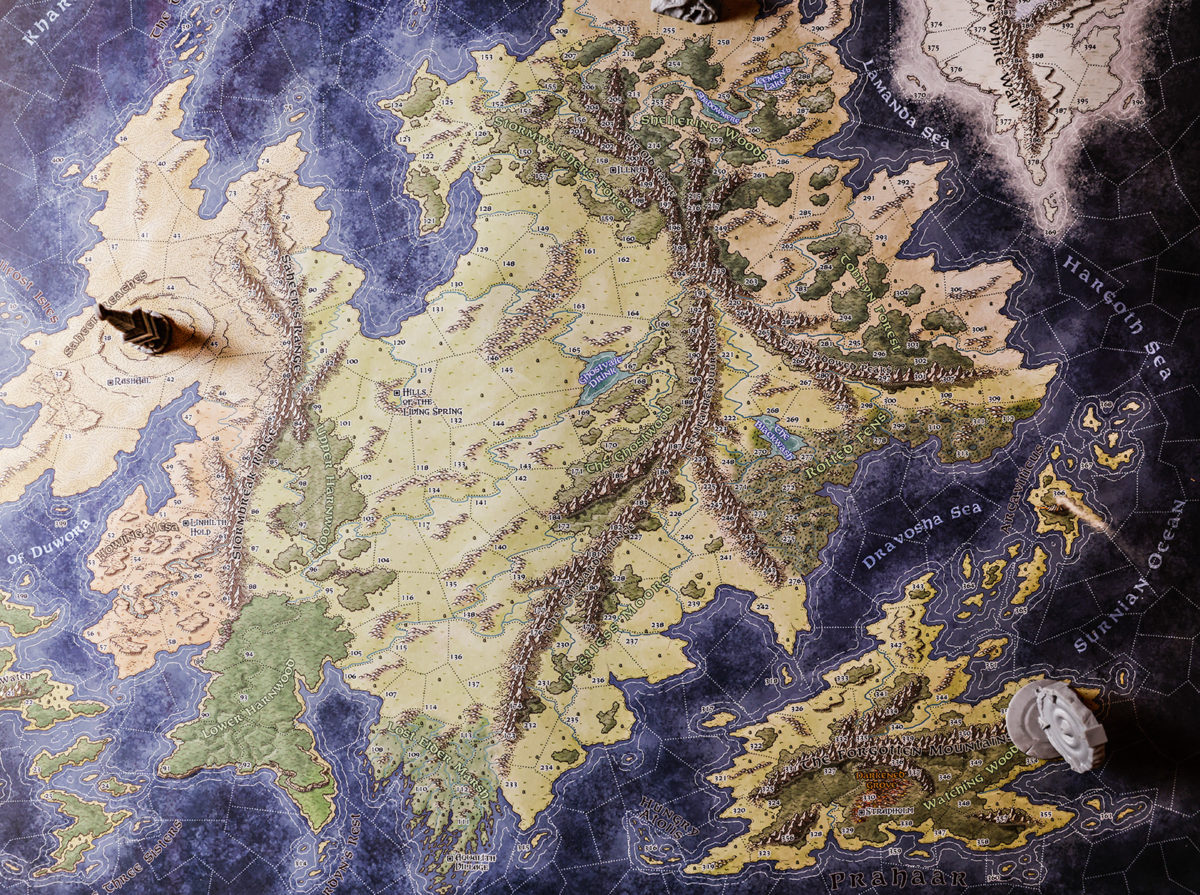
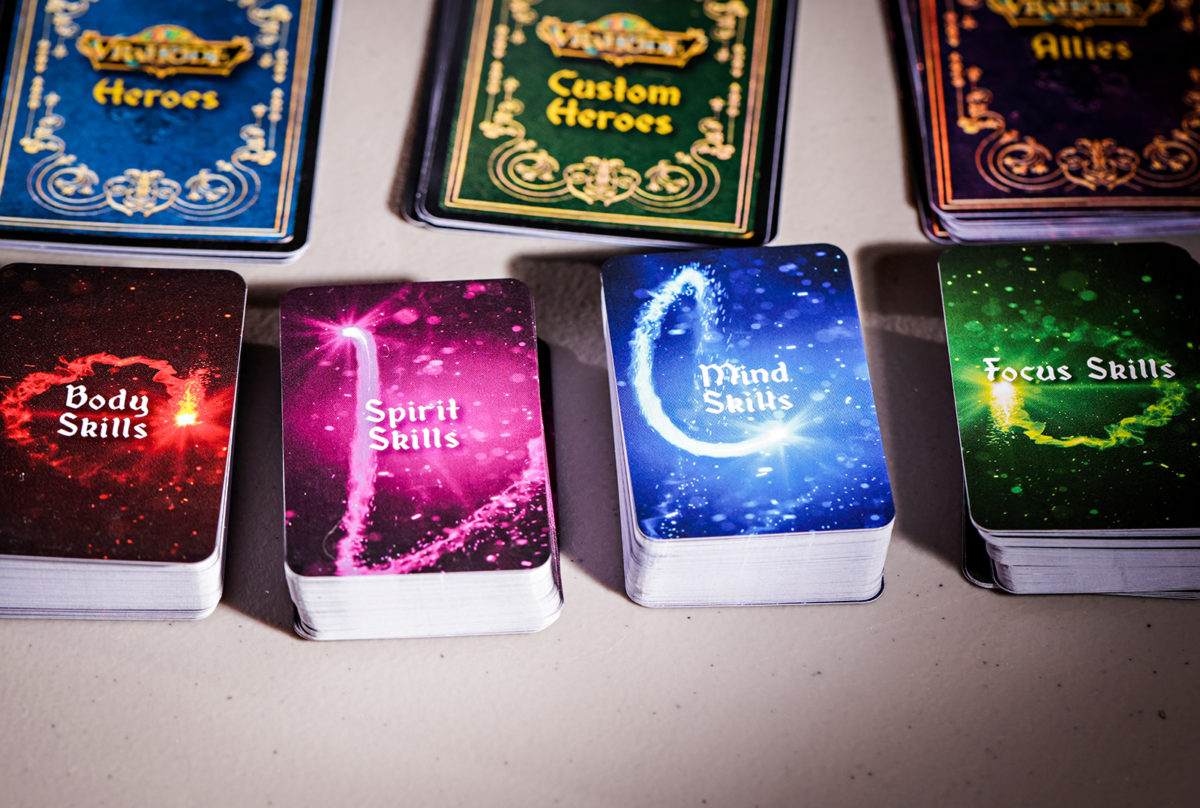
One aspect of the game that especially excites Irving is what he’s described as a one-of-a-kind game element dubbed the Harbinger Gaming Terrain System. That system will allow players who are exploring dungeons on one of the detailed breakout boards to create 3D spaces using a system of interlocking tiles and other pieces that can be assembled to build up the board vertically.
There’s no “dungeon master” type player who is calling the shots for the various enemies that players face. Instead, Irving has worked on developing a kind of airtight rule system that dictates how enemies behave during encounters, which will be up to players to abide by. The rule system is the most difficult part of creating a game, Irving said. The discovery of a rule that isn’t compatible with gameplay can create an effect that Irving refers to as “breaking the game,” setting off a domino effect that can throw off the game’s design and symmetry. Ensuring that the storyline, side quests, battle system, item system and other core components of the game function correctly means trying to play out as many scenarios as possible until their conclusion.
“What we’ve done on this system, as complex as it looks, is every time we’ve had a choice for realism, or simplicity, we’ve gone the simplicity way. We want it to play fast. We want it to be fun, we want it to be accessible, we want it to have a very, very small learning curve,” Irving said. “We want young kids to play it, we want families to play it. We want content creators to play within our system, not something else.”
The complete game has 1,425 cards. In addition to employing artists from countries like Italy and Brazil, some of the environmental game art comes from the work of Whitefish artist Colt Idol. Ornate figurines representing various creatures also inhabit the game world, prototypes of which are currently 3D printed, but will eventually be manufactured through an injection-mold process.
In the coming months, Irving will be playtesting the game by himself before opening it up to external playtesting, at which point he’ll offer free food and prizes at local gaming stores in exchange for people volunteering to play the game while he takes notes on gameplay and player feedback. A game trailer is expected to come out in the summer of 2023, and then a crowdfunding effort will start next fall. The plan right now is to start manufacturing the game and its expansions in January 2024, and to get the game in players’ hands by that spring.
“It’s plenty violent, but it also has a heart,” Irving said. “There’s a message to this game in that you have to kill things that are part of the natural world. And the heroes have to have a reckoning for that, and they do. And that’s what we wanted to do in the story is say hey, you’ve had to sacrifice a lot of wonderful things to do what you had to do to save the world, and now you have to revisit where your moral compass is. And so, we do. We give the game a heart.”